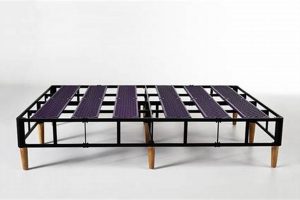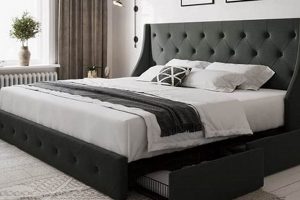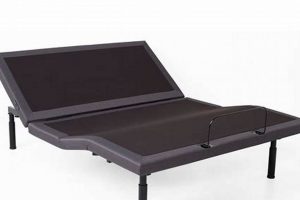Placing a smaller mattress on a larger bed frame involves utilizing a non-standard configuration. Specifically, this refers to positioning a 54-inch wide by 75-inch long mattress onto a bed frame designed to accommodate a 60-inch wide by 80-inch long mattress. This arrangement leaves an exposed portion of the bed frame. This configuration may arise from various circumstances, such as utilizing existing furniture or addressing temporary spatial limitations.
The practice offers potential advantages and disadvantages. One potential benefit includes cost savings if one already owns both the mattress and frame and wishes to avoid purchasing a new, correctly sized set. Historically, adapting existing resources to fulfill needs has been a common practice, particularly when resources are limited. However, aesthetic concerns and potential functional drawbacks, such as the possibility of items falling into the gap between the mattress and frame, should also be considered. Furthermore, it may impact the structural integrity and intended support offered by the bed frame.
Subsequent sections will address the practical considerations, aesthetic implications, and potential solutions associated with employing a smaller mattress on a larger frame. Detailed explorations into the benefits and drawbacks will be provided, alongside potential modifications and alternatives designed to optimize comfort, safety, and visual appeal.
Practical Considerations When Using a Full Size Mattress on a Queen Frame
Employing a smaller mattress on a larger bed frame necessitates careful consideration. These tips offer guidance on mitigating potential issues and optimizing the configuration.
Tip 1: Assess Gap Dimensions: Accurately measure the space between the mattress and the frame. This measurement is critical for selecting appropriate gap-filling solutions.
Tip 2: Utilize Gap Fillers: Employ foam inserts, rolled towels, or custom-made cushions to fill the space. These fillers prevent items from falling into the gap and provide edge support.
Tip 3: Implement a Bed Skirt: A bed skirt conceals the exposed frame, improving the aesthetic appearance and minimizing visual discrepancies.
Tip 4: Consider a Platform Insert: A solid platform placed within the queen frame can provide a stable, level surface for the smaller mattress, distributing weight more evenly.
Tip 5: Prioritize Safety: Ensure the mattress is securely positioned to prevent shifting. Consider non-slip pads or strips beneath the mattress to maintain its placement.
Tip 6: Evaluate Long-Term Suitability: Recognize that this configuration is often a temporary solution. Evaluate whether investing in a correctly sized mattress and frame is a more practical long-term investment.
Tip 7: Check Frame Support: Verify the frame provides adequate support for the smaller mattress. Reinforce the frame if necessary to prevent sagging or instability.
Adhering to these recommendations can enhance the functionality and appearance of a smaller mattress on a larger frame, while prioritizing safety and stability.
The subsequent section will explore aesthetic enhancements to address visual inconsistencies associated with this unconventional bed setup.
1. Frame gap management
When a 54-inch wide full size mattress is placed upon a 60-inch wide queen size frame, a gap inevitably results. This disparity necessitates strategic “frame gap management.” The failure to adequately address this gap directly impacts the mattress’s stability and the overall aesthetic. For instance, without proper filling, the edges of the mattress are unsupported, leading to potential sagging and reduced lifespan. Furthermore, smaller items, such as phones or remotes, may fall into the crevice, causing inconvenience and potential loss. Therefore, appropriate gap management is paramount for the usability and presentability of the configuration.
Effective “frame gap management” encompasses various techniques. Foam inserts, custom-cut to size, offer a tailored solution for filling the void and providing edge support. Alternatively, rolled towels or strategically placed pillows can serve as temporary fillers. A bed skirt, while primarily aesthetic, can mask the visual incongruity created by the gap. In situations where more robust support is needed, wooden planks or plywood sheets can be placed within the frame to provide a solid base and eliminate the gap entirely. These practical solutions allow for utilization of both the mattress and frame without significant compromise to functionality or visual appeal.
In summary, the significance of “frame gap management” in the context of a smaller mattress on a larger frame cannot be overstated. It directly influences mattress support, prevents loss of items, enhances visual appeal, and contributes to a more stable and usable sleep environment. While the arrangement may be a temporary solution, effective gap management ensures that it is a safe and comfortable one. Addressing gap challenges provides immediate relief and improves overall comfort in situations where obtaining correctly sized components is not immediately possible.
2. Mattress support concerns
The utilization of a smaller mattress on a larger frame introduces inherent “Mattress support concerns” that must be addressed. When a full size mattress is placed on a queen size frame, the intended support structure is compromised, potentially impacting the sleeper’s comfort and the mattress’s longevity. Addressing these concerns is critical for ensuring a functional and comfortable sleep environment.
- Edge Support Deficiency
A significant consequence of this configuration is the lack of edge support. The perimeter of the full size mattress may not be adequately supported by the queen frame, leading to sagging or compression over time. For example, individuals who sit on the edge of the bed to dress may experience a noticeable lack of support, potentially contributing to discomfort and mattress degradation.
- Uneven Weight Distribution
The queen frame is designed to distribute weight evenly across a larger surface area. Placing a smaller mattress on this frame concentrates the weight in a smaller region. This can lead to uneven stress on the frame and the mattress, potentially accelerating wear and tear. Consider a scenario where two individuals sleep on the full size mattress; the concentrated weight may cause the underlying frame to bow or weaken over time.
- Compromised Spinal Alignment
Insufficient or uneven support can negatively impact spinal alignment during sleep. A mattress that is not properly supported may sag in certain areas, causing the sleeper’s body to contort into unnatural positions. Over time, this can contribute to back pain, stiffness, and other musculoskeletal issues. The original design considerations for spinal support in the larger frame become irrelevant due to the smaller mattress size.
- Frame Instability
The mismatch in size can also lead to frame instability. If the mattress shifts or moves on the frame, it can create an unstable sleeping surface. This instability may be particularly noticeable when getting in or out of bed, or during sleep movements. Furthermore, the lack of a snug fit can result in increased noise and vibration, disrupting sleep quality.
In conclusion, the connection between “Mattress support concerns” and a full size mattress on a queen frame is significant. The resulting lack of edge support, uneven weight distribution, compromised spinal alignment, and potential frame instability necessitate proactive solutions to mitigate these issues. Implementing gap fillers, platform inserts, or reinforcing the frame can help to improve support and create a more stable and comfortable sleep surface, although such measures are often considered temporary pending the acquisition of appropriately sized bedding components.
3. Aesthetic inconsistencies
The placement of a full size mattress on a queen size frame invariably introduces “Aesthetic inconsistencies,” arising primarily from the visible disparity in dimensions. The visual gap between the mattress and the frame creates an unbalanced appearance, disrupting the intended proportions of the bed. This deviation from standard bed arrangements can detract from the overall visual harmony of the bedroom, impacting its perceived sophistication and stylistic coherence. For instance, a meticulously decorated bedroom may appear less refined if the bed, typically a focal point, exhibits an ill-fitting mattress.
The prominence of these “Aesthetic inconsistencies” is further accentuated by the exposed bed frame, which can reveal unfinished surfaces or hardware not intended to be visible. Standard bedding, such as comforters and bedspreads designed for queen size beds, may drape improperly over the smaller mattress, exacerbating the visual imbalance. Consider a scenario where an expensive, tailored bedspread hangs unevenly, revealing the bare frame beneath; the intended luxurious effect is diminished by the incongruent mattress size. The practical significance of addressing these inconsistencies lies in maintaining the aesthetic integrity of the bedroom and fostering a sense of visual order and completeness.
In conclusion, the connection between “Aesthetic inconsistencies” and using a full size mattress on a queen frame is evident, primarily stemming from the dimensional mismatch and its effects on visual harmony. Addressing these inconsistencies is crucial for preserving the aesthetic appeal of the bedroom environment. While functional solutions such as gap fillers and modified bedding can mitigate the visual impact, the fundamental challenge remains the disproportionate relationship between the mattress and the frame. Recognizing and addressing these aesthetic considerations contribute significantly to the overall satisfaction with the bedroom’s design and ambiance.
4. Safety implications
The dimensional disparity between a full size mattress and a queen size frame introduces inherent “Safety implications.” This unconventional arrangement presents potential hazards that necessitate careful consideration and mitigation strategies to ensure a safe sleeping environment.
- Increased Risk of Falls
The gap between the mattress and the frame creates a potential tripping hazard, particularly for individuals with mobility limitations or during nighttime navigation. The unexpected void can lead to accidental falls, especially when getting in or out of bed. Elderly individuals or those with impaired vision are particularly vulnerable to this risk. The absence of a consistent edge increases the likelihood of missteps and subsequent injuries.
- Entrapment Hazards
The space between the mattress and frame can become a potential entrapment hazard, especially for children or pets. Small limbs can become lodged in the gap, leading to discomfort, injury, or, in extreme cases, suffocation. The risk is heightened when the gap is narrow and difficult to access, impeding prompt assistance in case of entrapment. Careful monitoring and preventative measures are crucial to mitigate this danger.
- Unstable Sleeping Surface
The mismatch in size can result in an unstable sleeping surface, increasing the risk of falls and injuries during sleep. The mattress may shift or slide on the frame, particularly with movement. This instability can lead to disturbed sleep patterns and potential injuries resulting from unexpected shifts or falls during the night. Ensuring a secure and stable mattress placement is essential for minimizing this risk.
- Compromised Structural Integrity
The queen size frame is designed to support a larger, heavier mattress. When supporting a smaller mattress, the frame’s weight distribution is altered, potentially compromising its structural integrity. Over time, this can lead to frame damage, instability, and an increased risk of collapse. Regular inspection and reinforcement of the frame may be necessary to prevent structural failure and ensure the safety of the sleeping environment.
Addressing these “Safety implications” is paramount when utilizing a full size mattress on a queen size frame. Implementing appropriate gap fillers, ensuring mattress stability, and regularly inspecting the frame can significantly reduce potential hazards. While this configuration may be a temporary solution, prioritizing safety measures is essential to prevent accidents and injuries.
5. Temporary solutions
Employing a full size mattress on a queen size frame invariably suggests provisionality. The mismatch in dimensions necessitates adaptive measures, which are inherently temporary in nature. This configuration often arises from circumstances such as budget constraints, transitional living situations, or the immediate availability of existing resources. The resulting arrangement serves as an interim solution until a mattress and frame of compatible sizes can be acquired. For example, a student relocating to a new apartment may utilize existing bedding temporarily before investing in appropriately sized furniture. The practical significance lies in providing a functional, albeit imperfect, sleep environment during a period of transition.
The employment of gap fillers, such as rolled towels or foam inserts, represents a direct manifestation of “Temporary solutions.” These measures address immediate concerns related to mattress support and potential hazards. Similarly, bed skirts and strategically placed blankets are often used to mitigate aesthetic inconsistencies, offering a visual improvement without addressing the underlying dimensional incompatibility. In practical terms, these solutions acknowledge the short-term nature of the arrangement, focusing on functionality and visual appeal within the constraints of the existing resources. The implementation of such stopgap measures reflects a pragmatic approach to immediate needs, acknowledging that a more permanent solution is ultimately desirable.
In summary, the connection between “Temporary solutions” and utilizing a full size mattress on a queen frame is inextricably linked. The dimensional mismatch inherently necessitates short-term adaptive strategies to address functional, safety, and aesthetic concerns. These measures offer practical relief during transitional periods, providing a functional sleep environment while acknowledging the need for a more permanent and appropriately sized bedding arrangement. Recognizing the temporary nature of this configuration allows for a pragmatic approach to immediate needs while planning for a more sustainable long-term solution.
Frequently Asked Questions
The subsequent section addresses common inquiries regarding the utilization of a smaller mattress on a larger bed frame. The information provided aims to clarify potential concerns and offer practical guidance.
Question 1: Is it structurally sound to place a full size mattress on a queen size frame?
Structural integrity can be compromised if the frame does not provide adequate support for the smaller mattress. Reinforcement measures or platform inserts may be necessary to ensure stability.
Question 2: What are the primary safety hazards associated with this arrangement?
Potential hazards include increased risk of falls, entrapment in the gap between the mattress and frame, and an unstable sleeping surface due to mattress shifting.
Question 3: How can the aesthetic discrepancies be minimized?
Employing a bed skirt, strategically draping blankets, or utilizing custom-fitted bedding can help conceal the exposed frame and create a more visually balanced appearance.
Question 4: What is the best method for filling the gap between the mattress and the frame?
Foam inserts, custom-cut to size, offer a tailored solution. Alternatively, rolled towels or strategically placed pillows can provide temporary support and prevent items from falling into the gap.
Question 5: Will this configuration damage either the mattress or the frame over time?
Uneven weight distribution and lack of edge support can accelerate wear and tear on both the mattress and the frame, particularly if the arrangement is not properly supported.
Question 6: Is this arrangement a suitable long-term solution?
This configuration is generally considered a temporary solution. Investing in a properly sized mattress and frame is recommended for optimal comfort, support, and safety over the long term.
In summary, while utilizing a smaller mattress on a larger frame may offer a temporary solution, careful consideration of structural integrity, safety hazards, and aesthetic discrepancies is essential. Addressing these concerns with appropriate mitigation strategies can enhance the functionality and safety of the arrangement.
The next section will explore alternative solutions to address the challenges posed by this non-standard bed setup.
full size mattress on queen frame
This article explored the complexities associated with utilizing a full size mattress on a queen size frame. Considerations involving structural support, safety hazards, aesthetic inconsistencies, and the inherently temporary nature of such an arrangement were examined. Mitigating strategies, including gap management techniques and safety precautions, were presented as methods for addressing immediate concerns arising from the dimensional mismatch. The limitations of these strategies underscore the provisional nature of the configuration.
Given the potential compromises in safety, support, and aesthetics, the long-term suitability of a full size mattress on a queen frame is questionable. Individuals facing this situation are encouraged to assess their specific needs and circumstances, considering the acquisition of appropriately sized components as a more sustainable and optimized solution for sleep quality and overall well-being. Prioritizing long-term comfort and safety outweighs the short-term convenience of utilizing mismatched bedding components.


![Best Queen Futon Frame with Mattress [Deals & Guide] Organic & Natural Mattress Buyer’s Guide: Non-Toxic Sleep Solutions Best Queen Futon Frame with Mattress [Deals & Guide] | Organic & Natural Mattress Buyer’s Guide: Non-Toxic Sleep Solutions](https://mattressworldpa.com/wp-content/uploads/2025/07/th-3062-300x200.jpg)
![Best California King Mattress Frame [Guide & Deals] Organic & Natural Mattress Buyer’s Guide: Non-Toxic Sleep Solutions Best California King Mattress Frame [Guide & Deals] | Organic & Natural Mattress Buyer’s Guide: Non-Toxic Sleep Solutions](https://mattressworldpa.com/wp-content/uploads/2025/07/th-3061-300x200.jpg)


![Best Twin Size Frame and Mattress [Guide] Deals! Organic & Natural Mattress Buyer’s Guide: Non-Toxic Sleep Solutions Best Twin Size Frame and Mattress [Guide] Deals! | Organic & Natural Mattress Buyer’s Guide: Non-Toxic Sleep Solutions](https://mattressworldpa.com/wp-content/uploads/2025/07/th-3058-300x200.jpg)
